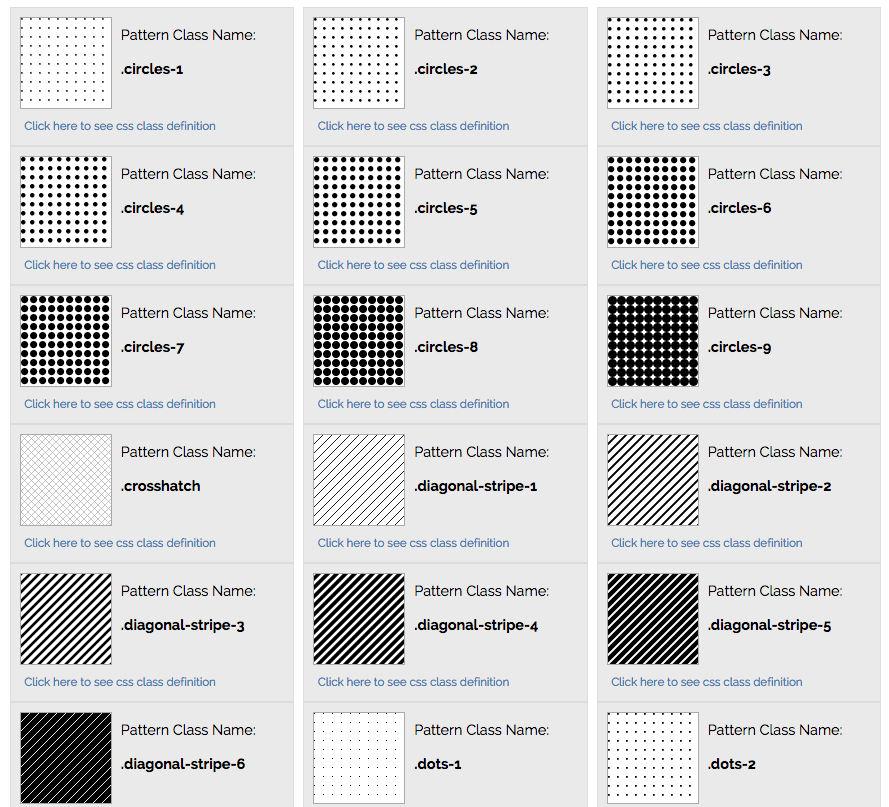See the live site here: http://iros.github.io/patternfills/
This is a collection of svg-based pattern fills that can be used both as SVG patterns defs and CSS background image urls. There is also an example of how one might use pattern fills with d3.js.
A lot of these pattens started from: http://philbit.com/svgpatterns/ which is an amazing project.
All the patterns live under src/patterns. Each file is a single svg file containing the pattern itself and nothing else.
To view any of the patterns, one must build the sample files. There are three of them that are created:
public/sample_svg.html- a raw sample of using the pattens within SVG.public/sample_css.html- a sample of using the patterns after they are converted to css image urls. See the accompanyingpattern.css.public/sample_d3.html- a sample of d3 code that generates the same exact output thatsample_svg.htmldoes, but using d3.js.
You can use the patterns as indicated via the website:
- By downloading the
pattern.cssfile - Copying individual CSS / SVG snippets into your source
You can install patternfills via npm like so:
npm install -g patternfills
It comes with an executable that will allow you to produce the CSS classes or the SVG classes and save them to an appropriate file. This might come in handy when you want to integrate patternfills into your build process.
To produce either the css, svg or a set of svg files you can run:
patternfills --format=svg|css|files
You can provide a destination like so
patternfills --format=svg|css|files --dest=your/path
Note that if you are outputing files you need to provide a folder. Otherwise you need to provide a single file name.
And even point to a different pattern set like this:
patternfills --format=svg|css|files --source=your/patterns
In this project, we are using patterns in two different ways:
- Using actual patterns for svg
- Using base64 encoded strings for css-based fills.
SVG images are typically smaller than bitmap images and remain sharp on high-dpi screens. Unlike CSS3 gradients, SVG images are supported on IE9. (source: http://philbit.com/svgpatterns/#whysvg)
To define a pattern that can then be used in svg, one must add it to the defs section of an svg container:
<svg height="8" width="8" xmlns="http://www.w3.org/2000/svg" version="1.1">
<defs>
<pattern id="crosshatch" patternUnits="userSpaceOnUse" width="8" height="8">
<image xlink:href="data:image/svg+xml,<svg xmlns='http://www.w3.org/2000/svg' width='8' height='8'><path fill='#fff' d='M0 0h8v8h-8z'/><path d='M0 0l8 8zm8 0l-8 8z' stroke-width='.5' stroke='#aaa'/></svg>" x="0" y="0" width="8" height="8">
</image>
</pattern>
</defs>
</svg>
Important parts to note about this section are:
- The pattern id string
To use the pattern to color in some svg element, like a rect, simply set the style attribute fill to the string: url(#patternName) #fallbackcolor. For example:
<svg height="150" width="150" style="float:left">
<rect style="fill: url(#crosshatch) #fff;" x="0" y="0" height="150" width="150">
</rec>
</svg>
Css patterns utilize image fills. For exmple, the following is a definition of one of our patterns, converted to base64 string and turned into a css class definition:
.crosshatch {
background-image: url("data:image/svg+xml,<svg xmlns='http://www.w3.org/2000/svg' width='8' height='8'><path fill='#fff' d='M0 0h8v8h-8z'/><path d='M0 0l8 8zm8 0l-8 8z' stroke-width='.5' stroke='#aaa'/></svg>");
background-repeat: repeat;
}
Then simply use the class name:
<div style="width: 150px; height: 150px; float:left" class="crosshatch">
</div>
First, set up your development environemnt, if you haven't already:
yarn install
Then open two terminal windows, both at the root of this repository. From one, run:
grunt dev - this will watch for any changes under the src directory and rebuild the sample files, while running a dev server.
From the other run:
grunt connect - this will fire up a server on localhost running on port 8000. Navigate to that url to one of the sample files you wish to see (http://localhost:8000/sample_svg.html, http://localhost:8000/sample_d3.html or http://localhost:8000/sample_css.html).
The project is setup with live reloading, so that any time you modify any of the pattern files you will see your page automatically reload.
You can build the website any time by just calling grunt render or simply grunt.
The files will be built and put into the public folder. If you don't intend to customize the patterns or add new ones, you can simply look at the generated code and use it for your own needs.
Ideally, this pattern library will grow and contain many new patterns! Please submit yours in a pull request and I will be more than happy to merge them if they work appropriatly.
Currently some of our patterns are:
But you should check them all out at http://iros.github.io/patternfills/


